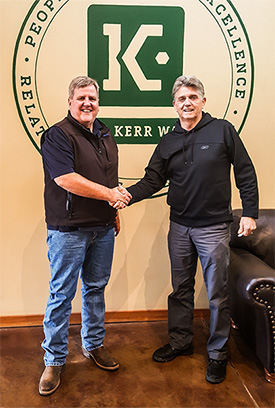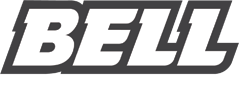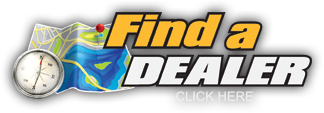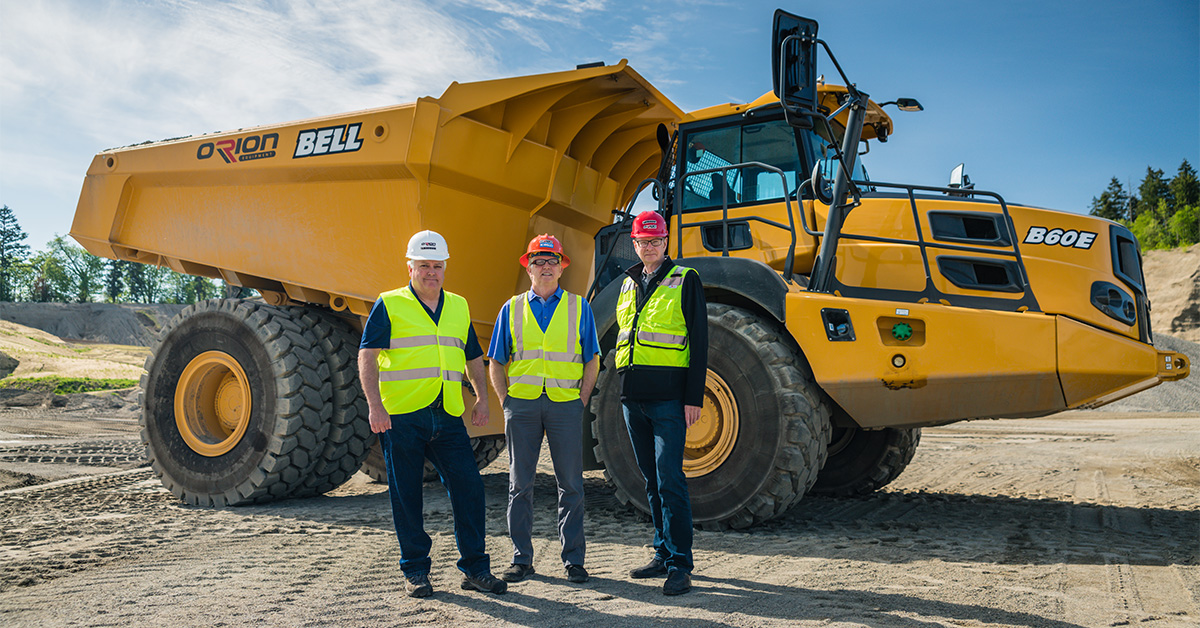When you’re in an area that gets an average of 180 days of rain a year, equipment productivity and efficiency are crucial for maintaining your project schedule. Your equipment must work hard, be easy to operate and maintain, and able to handle nearly constant muddy conditions.
Orion Equipment in Seattle, Washington, took these factors, and more, into consideration when they chose to become a Bell Trucks America dealer in 2013.
Van Ruiter, President, and Jim Irish, Managing Director of Orion Equipment, have a background in the technical world of engine and transmission repair and rebuild as owners of Pacific Torque, a power train solutions provider. “We survived the 2008 recession, came out the other side and started to look at the growth opportunities for Pacific Torque,” Ruiter said.
In business for 35 years, Pacific Torque has serviced many types of construction equipment, everything from Genie telehandlers to rigid haul trucks, but has mainly focused on powertrains. Ruiter and Irish wanted to expand into an equipment dealership with all their service, parts and rebuild capabilities, and began searching for product lines that fit their vision and goals.
Why Orion Chose Bell Trucks
In 2013, they contacted Bell Trucks because they knew the history of Bell Equipment, and had done their share of repairs on everything from Moxy to Deere to Terex articulated trucks. They felt they knew the Bell product line very well. Orion Equipment then signed with Bell Trucks as their first product line, taking delivery of their first four Bell Trucks.
“Strategically, what we were doing with Pacific Torque was a nice fit to what you need to excel at on a heavy equipment dealer side,” Ruiter said. “We were a nice fit because we had service, overhaul and parts capability, logistics and rebuild and a core of excellent technicians.”
Signing with Liebherr brought dozers, wheel loaders, material handlers and scrap handling, then they signed on Wacker Neuson as a compact equipment dealer. Last was Kobelco for their full line of tracked excavators.
“One advantage we have is we limit the number of products we sell, ” Ruiter said. “This allows our sales team to really know our products and they convey that knowledge to the customer. Our sales guys, they just know everything about everything. That’s a differentiator.”
Ruiter and Irish like that Bell’s dedication and expertise is in one product line, articulated dump trucks. It’s a good decision for them, Ruiter says, because there’s not much bureaucracy and decisions get made quickly. “The Bell line is very competitive from a quality and price matrix point of view with a great, great product. We just need to continue to do what we do and get the Bell and Orion names out there.”
One of Orion’s big turning points was hiring Tom Williams, Strategic Accounts. Tom’s background with the former Totem Equipment gives him knowledge of heavy equipment, including mining, and he has a prior history with Bell Equipment. He was one of the first sales managers for Bell Equipment when they first came to North America selling forestry equipment in the 1980’s, and was the number one salesman for Bell in North America five years in a row. After Bell’s return to the US market in 2012, Tom was part of the team that sold the first five Bell Trucks in the Pacific Northwest. Tom is committed to the Bell line, he’s quite knowledgeable, and a staunch advocate for both his customers and Bell Trucks.
“If you believe in something, it’s easy to sell it, ” Tom said. “If I could spend 30 minutes with everyone in the US that buys articulated trucks, they’d all buy Bell Trucks, and I believe that. Not because I’m good, but because they aren’t aware of everything the Bell Truck can do.”

Brent Kerr & Tom Williams
The first Bell trucks sold by Orion were B50D’s purchased by Kerr Construction in Portland, Oregon. For owner Brent Kerr, the Allison transmission and Fleetmatics were what sold the trucks.
“I ground on it pretty hard and then I got into the computer system with reporting, telematics and Allison transmission,” Kerr said. “When you have a Volvo transmission and drop box out, you’re looking at an $80,000 bill, but with Bell, it’s a $17,000 bill for a repair and rebuild. Between the telematics and Allison transmission, I just said I’ll give anything for these trucks and when I’m done, I’ll run them forever.”
After he bought the B50D’s, Kerr started looking at his rigid truck fleet, comparing the new B60E to their 775 CATs, a 70 ton rigid frame truck, and said he made an easy choice. “The B60E adapted to our environment here of rain, mud and rock mix, and our western oriented rock pits that have seams of clay in them, so we’re always dealing with mud.”
The B60E turns on a dime, gets great traction control, it’s definitely an all-weather truck. Jim Irish says the niche Bell has against all competitors is with the 50 ton and a 60 ton trucks, and each has its own attributes that makes it succeed in the marketplace. The 60 ton hauls the weight, but has a tight turning radius, traction and does everything customers need it to do. The 50 ton is more of a 6×6 truck that will compete with other 45 ton trucks being offered, but will go anywhere because of its wide tire base, its sure footedness and ability to go through mud where others give up and get stuck.
“It’s been raining up here forever and these trucks just outshine everyone else in this weather,” said Jim Irish.
“It’s been raining up here forever and these trucks just outshine everyone else in this weather,” said Irish.
Another savings for Kerr was the ease of transporting the B60E. Preparing a 775 CAT rigid frame truck for transport requires the removal of parts like the fenders, cat walks and tires, and removing tires obviously makes the whole loading process logistically difficult. In contrast, when loading a B60E, you simply drive it on a lowboy, chain it down and go. It’s just like moving a smaller machine. “That in itself sold me on the 60 ton,” he said. “But then, once we tried it on a demo, it was the turning radius, fuel efficiency and telematics (Fleetmatics), that sold me. It was an easy decision.”
When someone like Brent Kerr starts purchasing Bell Trucks, other equipment managers and owners sit up and take notice. According to Ralph LoPriore, Director of Fleet Assets and Processes at Gary Merino Construction Company, “Brent knows equipment more than any other owner. There are owners and wanna be’s and Brent is the all bases covered guy,” said LoPriore.
“Nobody wants to do the homework,” he said. “Every year, every model, you better be looking at what’s going on to make your business more money.”
And LoPriore does his homework. He says he isn’t as expert, but he’s practical. “If I buy something new, I baseline everything,” he said. “I can say here are the baseline levels when it’s brand new. Now I try to achieve those levels throughout the life of the machine, I try to better those levels now instead of five years down the road, when you see problems and it’s already too late. Nobody does that.”
LoPriore’s number one priority is to choose something that’s robust, reliable and proven, and then from there he starts dissecting it – price, economy, how it’s put it together. That’s how he says you make the right decision.
“When I started doing analysis on Bell Trucks, I realized I’m already saving on the production side,” he said. “Then I look at the telematics and I’m getting what I want as far as the day-by-day, play-by-play, like do we have the right trained people in the truck. You can check your production, and Fleetmatics can show how many events per day you need to change. If you didn’t have this tool, you can’t tell if a problem has been handled.”
After his first demo with Bell, LoPriore was convinced transitioning from Komatsu to Bell was the way to go. He says the price is better and the trucks are robust compared to some competitive models, and adding in fuel economy made the picture clear.
“Going with Bell starts to be the right decision,” he said. “Not just any decision, but the right one. So, we bought one truck and then we liked that, and now we have three and they are performing quite well.”
What’s next for Orion Equipment?
Van Ruiter is optimistic with Orion’s place in the Pacific Northwest heavy equipment market, specifically with articulated trucks.
“We’re not only going head to head with artic trucks, we’re also going head to head with rigids,” he said. “I think there’s a lot of opportunity with the B50E’s and B60E’s to replace that rigid market. When customers see the fuel economy, productivity, comfort of the truck, the ‘drive it on drive it off’ ease of moving it and Fleetmatics, I think there’s going to be a surprising amount of momentum out there. We just need to be able to respond to the demand.”
He says there are CAT players, Komatsu players, Deere players, but once you get into the Bell 50-60 ton world, there isn’t anything comparable out there in trucks.
“Van and I are actively engaged in going to seeing customers and showing our participation with customers,” Jim Irish said. “That’s what it takes to succeed – a service and a relationship with the customers and having a fine, quality product like Bell Trucks.”


